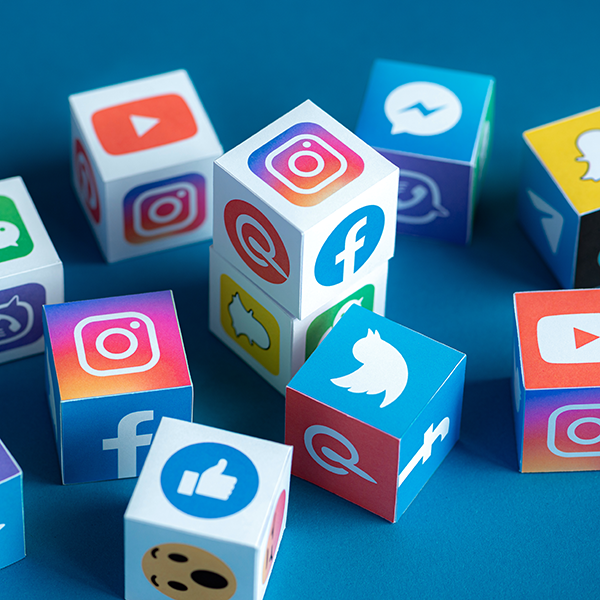Social Media Glossary

Social networks have not only changed the way we communicate with one another online, but also the way we speak offline.
Terms that likely didn't even exist 10 years ago, are now part of society's everyday language, and more phrases are added regularly. The constantly changing social landscape can make it difficult to stay current with this industry's expanding lexicon, which is not a good thing for marketers or other business professionals tasked with being ahead of the curve.
To avoid being left out of the social conversation, get familiar with this industry's lingo below.
Editor's Note: This is just the beginning of the "Social Media Glossary." Please add any missing terms in the Comment Section at the end of the article.
A
Aggregator - a Web-based tool or application that gathers and displays content from a variety of sources to an end-user.
Avatar - the primary image associated with a social network member's account.
B
Board - a Pinterest feature that allows users to organize the content that they have "pinned."
C
Check-In - an action that connects a person to a physical location. People can "check-in" to locations on social networks like Facebook and Foursquare.
Circles - a Google+ feature that allows users to put people together into specified groups. Through this feature, Google+ users have the ability to share updates with specific groups of people in pre-defined "circles."
Comment - a public response to a status update or other piece of content.
Community - a feature on Google+ that allows members to create niche groups where people with similar interests can interact. Communities can be made public or kept private.
Connection - people who are part of a LinkedIn user's personal network. Similar to a Facebook "friend" or a Twitter "follower."
D
Dashboard - an administrative interface that typically allows users to monitor social network activity as well as take actions like sharing content.
Direct Message (DM) - a private conversation between two users on Twitter.
E
Engagement - a vague term that describes participation with a brand's content on social networks. Typically, brands take fan and follower actions such as likes, retweets, shares and comments into consideration when measuring engagement.
F
Facebook - the world's largest social network, with 1.23 billion monthly active users.
Fan - a Facebook user who follows a brand or business Page.
Favorite - an action that represents a user's approval of a piece of content on Twitter.
Follower - someone who has chosen to receive your tweets in their Twitter timeline.
Foursquare - a location-based social network that enables users to discover new locations and check-in, share and save places they have visited.
Friend - a Facebook connection between two people. Both parties must agree to become "friends" before a connection is made.
G
Google+ - a social network created by Google where users can share content and connect with other members.
Group - this feature is available on both LinkedIn and Facebook. It enables users to create a niche community where people with similar interests can communicate with each other. Similar to Google+ Communities.
H
Hangout - a feature available on Google+ that allows a group of people to have conversations and share content with each other. Users also have the ability to start video hangouts with up to 10 friends.
Hashtag - an interactive feature that allows social network users to relate a status update to a broader topic.
Handle - the name a Twitter member chooses to represent themselves. To interact with another Twitter member, users must address them with the @ symbol and the person's handle, such as @WebsiteMagazine.
I
Influencer - a brand's most valuable audience members. Typically, influencers are active in the social community and have the ability to sway the opinions of their followers.
Instagram - an online photo-sharing social network where users can share filtered photos and videos. Instagram is owned by Facebook.
Instagram Direct - a communication method that allows Instagram users to send photos and videos privately to another user.
L
Like - an action that social network users can take to show their approval of a status update. In addition, Facebook users can "Like" pages in order to receive the Page's status updates in their newsfeeds.
Lists - a curated group of Twitter users.
M
Meme - a humorous piece of content that is generally recognized by society. Typically, memes are shared by many people and quickly go viral.
Message - a private communication method between two or more users on Facebook.
N
Newsfeed - the home page of a social network that is updated with activity updates from a user's friends or followers.
P
Page - a Facebook profile for a business or a brand. Facebook users can "like" pages but they cannot be friends with pages.
Pinterest - a pinboard-style social network where users can share content and create theme-based collections.
Pin - a piece of content shared by Pinterest users.
Poke - a Facebook action that allows one user to interact with another user through a virtual "poke."
Profile - the web page of a social network user that displays any content that the user has shared.
Promoted Content - a way to increase the reach of a profile or a specific piece of content on social networks. Promoted content is paid for and thus an advertisement.
R
Retweet - an action that allows users to share another user's content on Twitter.
Rich Pin - pins that feature extra content, such as a map, product pricing, recipe details and more. There are multiple types of Rich Pins, including Place Pins, Article Pins, Product Pins, Recipe Pins and Movie Pins.
S
Sentiment - the implied attitude behind user comments. Social media monitoring tools can help brands measure sentiment in order to gauge the overall perception of a company or specific marketing promotions.
Share - an action that allows someone to publish content from another source. The content is "shared" to that user's personal social network.
Snapchat - a photo messaging mobile app that allows user to take photos or record videos and send them to selected friends. Each piece of content sent has a time limit (1-10 seconds) for viewing. After the content has been viewed it is not able to be seen again unless it is part of a Snapchat Story.
Snapchat Story - Snapchat users can put content into a "story" for 24-hour viewing. Typically, stories are made up of a string of content that creates a narrative.
Social Listening - a tool that enables users to monitor and measure what is being said about a brand on social networks.
Status Update - a piece of content shared by a social network member.
T
Timeline - Facebook's newest profile layout that display's a user's collection of shared content.
Trending Topic - the most popular topics currently being discussed on a social network.
Tumblr - a microblogging platform owned by Yahoo. Currently, Tumblr has more than 172 million blogs on its platform.
Tweet - a Twitter status update.
Twitter - a popular social network that allows users to post 140-character status updates.
U
URL Shortener - a tool that converts a long URL into a shortened version that is easier to share, especially on social networks.
V
Vine - a mobile app owned by Twitter that allows users to share short videos that play in a continuous loop.
Viral - a piece of content that is rapidly and organically shared.
W
Word-of-Mouth Marketing - an unpaid form or promotion by a customer on behalf of a brand.
Y
YouTube - a video sharing platform owned by Google.

Subscribe to Our Newsletter!
Latest in Social Media










